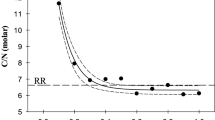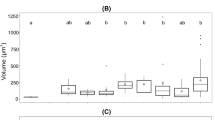Abstract
We conducted a laboratory experiment to investigate the influence of Daphnia infochemicals on growth rate, microcystin production, colony formation and cell size of eight Microcystis strains isolated from two lakes. The strains were characterized genetically by their 16S-23S rDNA ITS sequence. The experiment was composed of four treatments: (1) a control using filtered WC medium, (2) addition of Scenedesmus obliquus culture medium filtrate, (3) addition of Daphnia magna culture medium filtrate and (4) addition of sodium octyl sulphate, a commercially available Daphnia infochemical. Our results showed that sympatric strains differed strongly for the measured functional traits, while no correlations between traits were found. Between-strain differences in growth rate, microcystin production, colony formation and cell size were generally larger than the differences in phenotypes observed between treatments. Despite this, several strains reacted to the infochemicals by changing functional trait values. Daphnia culture medium filtrate and, to a lesser extent, sodium octyl sulphate had a negative influence on the growth rate of half of the strains and stimulated microcystin production in one strain, but the latter effect was not Daphnia-specific as Scenedesmus culture medium filtrate had the same effect. Daphnia culture medium filtrate also induced colony formation in one strain. Our data suggest that Daphnia infochemicals generally have a weak influence on growth rate, microcystin production and colony formation of Microcystis strains as compared to the inter-strain variability, while existing inducible effects are highly strain-specific.



Similar content being viewed by others
References
Bañares-España, E., V. Lopez-Rodas, C. Salgado, E. Costas & A. Flores-Moya, 2006. Inter-strain variability in the photosynthetic use of inorganic carbon, exemplified by the pH compensation point, in the cyanobacterium Microcystis aeruginosa. Aquatic Botany 85: 159–162.
Bañares-España, E., V. Lopez-Rodas, E. Costas, C. Salgado & A. Flores-Moya, 2007. Genetic variability associated with photosynthetic pigment concentration, and photochemical and nonphotochemical quenching, in strains of the cyanobacterium Microcystis aeruginosa. Fems Microbiology Ecology 60: 449–455.
Bonnet, E. & Y. Van de Peer, 2002. Zt: a software tool for simple and partial Mantel tests. Journal of Statistical software 7: 1–12.
Carrillo, E., L. M. Ferrero, C. Alonso-Andicoberry, A. Basanta, A. Martin, V. Lopez-Rodas & E. Costas, 2003. Interstrain variability in toxin production in populations of the cyanobacterium Microcystis aeruginosa from water-supply reservoirs of Andalusia and lagoons of Doñana National Park (southern Spain). Phycologia 42: 269–274.
Chorus, I. & J. Bartram, 1999. WHO. Toxic cyanobacteria in water: a guide to their public health consequences, monitoring and management. E and FN Spon, London, UK.
Christoffersen, K., B. Riemann, A. Klysner & M. Sondergaard, 1993. Potential role of fish predation and natural populations of zooplankton in structuring a plankton community in eutrophic lake water. Limnology and Oceanography 38: 561–573.
Czarnecki, O., M. Henning, I. Lippert & M. Welker, 2006. Identification of peptide metabolites of Microcystis (Cyanobacteria) that inhibit trypsin-like activity in planktonic herbivorous Daphnia (Cladocera). Environmental Microbiology 8: 77–87.
Ghadouani, A., B. Pinel-Alloul & E. E. Prepas, 2003. Effects of experimentally induced cyanobacterial blooms on crustacean zooplankton communities. Freshwater Biology 48: 363–381.
Guillard, R. R. & C. J. Lorenzen, 1972. Yellow-green algae with chlorophyllide c. Journal of Phycology 8: 10–14.
Ha, K., M. H. Jang & N. Takamura, 2004. Colony formation in planktonic algae induced by zooplankton culture media filtrate. Journal of Freshwater Ecology 19: 9–16.
Hansson, L. A., 1996. Behavioural response in plants: adjustment in algal recruitment induced by herbivores. Proceedings of the Royal Society of London Series B-Biological Sciences 263: 1241–1244.
Hansson, L. A., 2000. Synergistic effects of food chain dynamics and induced behavioral responses in aquatic ecosystems. Ecology 81: 842–851.
Hessen, D. O. & E. van Donk, 1993. Morphological changes in Scenedesmus induced by substances released from Daphnia. Archiv Fur Hydrobiologie 127: 129–140.
Hisbergues, M., G. Christiansen, L. Rouhiainen, K. Sivonen & T. Borner, 2003. PCR-based identification of microcystin-producing genotypes of different cyanobacterial genera. Archives of Microbiology 180: 402–410.
Huisman, J., H. C. P. Matthijs & P. M. Visser, 2005. Harmful Cyanobacteria. Springer, Dordrecht, The Netherlands: 243 pp.
Jang, M. H., K. Ha, G. J. Joo & N. Takamura, 2003. Toxin production of cyanobacteria is increased by exposure to zooplankton. Freshwater Biology 48: 1540–1550.
Jang, M. H., J. M. Jung & N. Takamura, 2007. Changes in microcystin production in cyanobacteria exposed to zooplankton at different population densities and infochemical concentrations. Limnology and Oceanography 52: 1454–1466.
Jang, M. H., K. Ha & N. Takamura, 2008. Microcystin production by Microcystis aeruginosa exposed to different stages of herbivorous zooplankton. Toxicon 51: 882–889.
Janse, I., W. E. A. Kardinaal, M. Meima, J. Fastner, P. M. Visser & G. Zwart, 2004. Toxic and nontoxic Microcystis colonies in natural populations can be differentiated on the basis of rRNA gene internal transcribed spacer diversity. Applied and Environmental Microbiology 70: 3979–3987.
Joung, S. H., C. J. Kim, C. Y. Ahn, K. Y. Jang, S. M. Boo & H. M. Oh, 2006. Simple method for a cell count of the colonial cyanobacterium, Microcystis sp. Journal of Microbiology 44: 562–565.
Kardinaal, W. E. A., I. Janse, M. Kamst-Van Agterveld, M. Meima, J. Snoek, L. R. Mur, J. Huisman, G. Zwart & P. M. Visser, 2007. Microcystis genotype succession in relation to microcystin concentrations in freshwater lakes. Aquatic Microbial Ecology 48: 1–12.
Lukač, M. & R. Aegerter, 1993. Influence of trace-metals on growth and toxin production of Microcystis aeruginosa. Toxicon 31: 293–305.
Luo, W., S. Pflugmacher, T. Proschold, N. Walz & L. Krienitz, 2006. Genotype versus phenotype variability in Chlorella and Micractinium (Chlorophyta, Trebouxiophyceae). Protist 157: 315–333.
Lürling, M., 1999. Grazer-induced coenobial formation in clonal cultures of Scenendesmus obliquus (Chlorococcales, Chlorophyceae). Journal of Phycology 35: 19–23.
Lürling, M. & E. van Donk, 1997. Morphological changes in Scenedesmus induced by infochemicals released in situ from zooplankton grazers. Limnology and Oceanography 42: 783–788.
Lürling, M. & E. van Donk, 1999. Grazer-induced colony formation in Scenedesmus acutus (Chlorophyceae): ecomorph expression at different temperatures. Journal of Phycology 35: 1120–1126.
Lürling, M., H. J. De Lange & E. van Donk, 1997. Changes in food quality of the green alga Scenedesmus induced by Daphnia infochemicals: biochemical composition and morphology. Freshwater Biology 38: 619–628.
Menden-Deuer, S. & E. J. Lessard, 2000. Carbon to volume relationships for dinoflagellates, diatoms, and other protist plankton. Limnology and Oceanography 45: 569–579.
Otsuka, S., S. Suda, S. Shibata, H. Oyaizu, S. Matsumoto & M. M. Watanabe, 2001. A proposal for the unification of five species of the cyanobacterial genus Microcystis Kutzing ex Lemmermann 1907 under the rules of the Bacteriological Code. International Journal of Systematic and Evolutionary Microbiology 51: 873–879.
Rohrlack, T., K. Christoffersen, M. Kaebernick & B. A. Neilan, 2004. Cyanobacterial protease inhibitor microviridin J causes a lethal molting disruption in Daphnia pulicaria. Applied and Environmental Microbiology 70: 5047–5050.
Sarnelle, O., 2007. Initial conditions mediate the interaction between Daphnia and bloom-forming cyanobacteria. Limnology and Oceanography 52: 2120–2127.
Selinummi, J., J. Seppala, O. Yli-Harja & J. A. Puhakka, 2005. Software for quantification of labeled bacteria from digital microscope images by automated image analysis. Biotechniques 39: 859–863.
Sivonen, K. & G. Jones, 1999. Cyanobacterial toxins. In Chorus, I. & J. Bartram (eds), Toxic Cyanobacteria in Water—A Guide To Their Public Health Consequences Monitoring And Management. E and FN Spon, London, England: pp. 41–111.
Vaitomaa, J., A. Rantala, K. Halinen, L. Rouhiainen, P. Tallberg, L. Mokelke & K. Sivonen, 2003. Quantitative real-time PCR for determination of microcystin synthetase E copy numbers for Microcystis and Anabaena in lakes. Applied and Environmental Microbiology 69: 7289–7297.
van der Oost, R., 2007. Cyanotoxine monitoring: standaardisering en validatie van methoden voor de Nederlandse Waterkwaliteitsbeheerders. Rapport STOWA onderzoek 2005 and 2006. Waternet/Waterproef, Amsterdam.
van Donk, E., 2007. Chemical information transfer in freshwater plankton. Ecological Informatics 2: 112–120.
van Donk, E., M. Lürling & W. Lampert, 1999. Consumer-induced changes in phytoplankton: inducibility, costs, benefits, and the impact on grazers. In Tollrian, R. & C. D. Harvell (eds), The Ecology and Evolution of Inducible Defenses. Princeton University Press, Princeton, NJ.
van Gremberghe, I., P. Vanormelingen, B. Vanelslander, K. Van der Gucht, S. D’hondt, L. De Meester & W. Vyverman, 2009. Genotype-dependent interactions among sympatric Microcystis strains mediated by Daphnia grazing. Oikos. doi: 10.1111/j.1600-0706.2009.17538.x.
Verschoor, A. M., I. Van Der Stap, N. R. Helmsing, M. Lürling & E. van Donk, 2004. Inducible colony formation within the Scenedesmaceae: adaptive responses to infochemicals from two different herbivore taxa. Journal of Phycology 40: 808–814.
Visser, P. M., B. W. Ibelings, L. R. Mur & A. E. Walsby, 2005. The ecophysiology of the harmful cyanobacterium Microcystis. Features explaining its success and measures for its control. In Huisman, J., H. C. P. Matthijs & P. M. Visser (eds), Harmful Cyanobacteria. Springer, Dordrecht, The Netherlands: pp. 109–142.
Wiedner, C., P. M. Visser, J. Fastner, J. S. Metcalf, G. A. Codd & L. R. Mur, 2003. Effects of light on the microcystin content of Microcystis strain PCC 7806. Applied and Environmental Microbiology 69: 1475–1481.
Wilson, A. E., O. Sarnelle, B. A. Neilan, T. P. Salmon, M. M. Gehringer & M. E. Hay, 2005. Genetic variation of the bloom-forming cyanobacterium Microcystis aeruginosa within and among lakes: implications for harmful algal blooms. Applied and Environmental Microbiology 71: 6126–6133.
Wilson, A. E., W. A. Wilson & M. E. Hay, 2006. Intraspecific variation in growth and morphology of the bloom-forming cyanobacterium Microcystis aeruginosa. Applied and Environmental Microbiology 72: 7386–7389.
Yang, Z. & J. J. Li, 2007. Effects of Daphnia-associated infochemicals on the morphology and growth of Scenedesmus obliquus and Microcystis aeruginosa. Journal of Freshwater Ecology 22: 249–253.
Yang, Z., F. X. Kong, X. L. Shi & H. S. Cao, 2006a. Differences in response to rotifer Brachionus urceus culture media filtrate between Scenedesmus obliquus and Microcystis aeruginosa. Journal of Freshwater Ecology 21: 209–214.
Yang, Z., F. X. Kong, X. L. Shi & H. S. Cao, 2006b. Morphological response of Microcystis aeruginosa to grazing by different sorts of zooplankton. Hydrobiologia 563: 225–230.
Yasumoto, K., A. Nishigami, M. Yasumoto, F. Kasai, Y. Okada, T. Kusumi & T. Ooi, 2005. Aliphatic sulfates released from Daphnia induce morphological defense of phytoplankton: isolation and synthesis of kairomones. Tetrahedron Letters 46: 4765–4767.
Acknowledgements
We thank Jeroen Van Wichelen and Renaat Dasseville for sampling lake Leeuwenhof, Victor Chepurnov for isolating the Microcystis strains and Caroline Souffreau for helping with the sampling during the experiment. This research was financially supported by ESF EURODIVERSITY project BIOPOOL (nationally supported by BELSPO—Belgian Science Policy and FWO—Fonds Wetenschappelijk Onderzoek Vlaanderen) and Belgian project B-BLOOMS2 (nationally supported by BELSPO).
Author information
Authors and Affiliations
Corresponding author
Additional information
Handling editor: D. P. Hamilton
Rights and permissions
About this article
Cite this article
van Gremberghe, I., Vanormelingen, P., Van der Gucht, K. et al. Influence of Daphnia infochemicals on functional traits of Microcystis strains (Cyanobacteria). Hydrobiologia 635, 147–155 (2009). https://doi.org/10.1007/s10750-009-9907-5
Received:
Revised:
Accepted:
Published:
Issue Date:
DOI: https://doi.org/10.1007/s10750-009-9907-5




